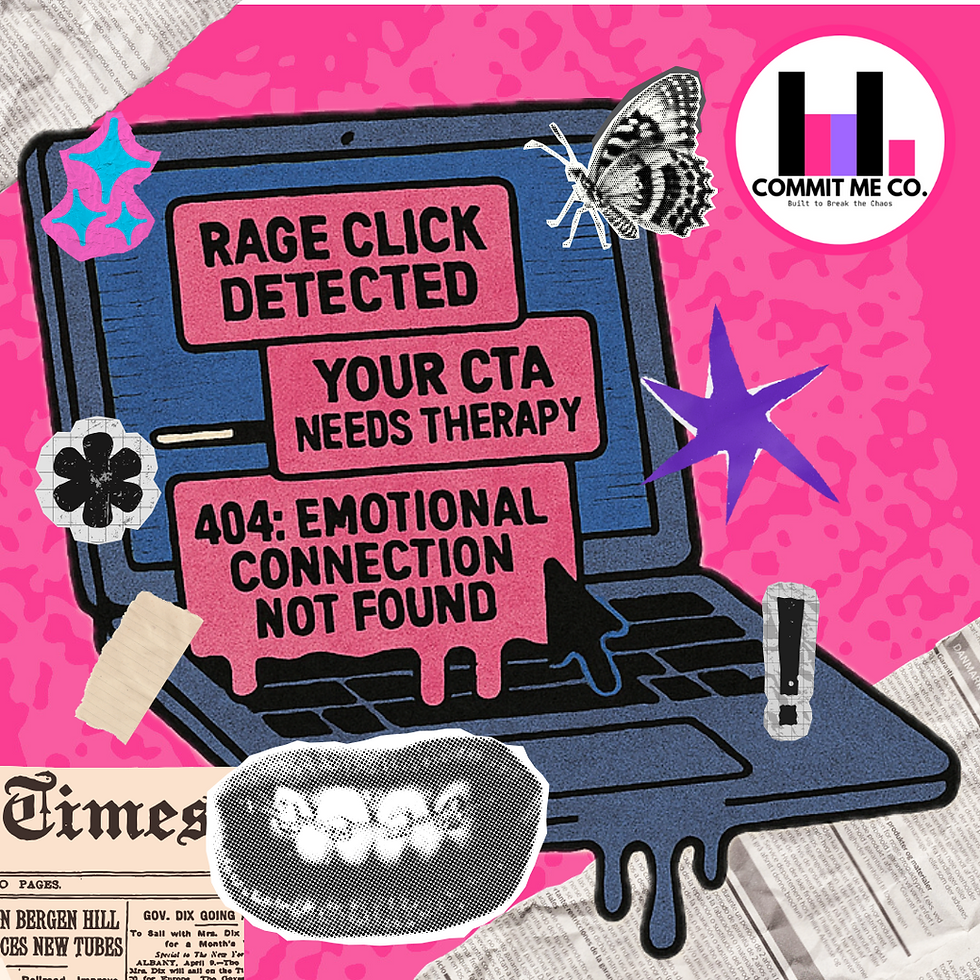Your Website Is a Psychological Environment
- Emily Neuhoff
- Aug 6
- 3 min read
(And Most of Us Are Accidentally Designing for Confusion)

The quiet truth:
Your website is less like a brochure and more like a mini cognitive lab.
Every click, pause, scroll, and bounce is data — not just about your brand, but about how humans navigate uncertainty, make decisions, and build trust.
At Commit Me Co, we treat websites like nervous systems — wired for perception, reaction, and emotional resonance. So we started asking:
What if your site isn’t just underperforming — what if it’s triggering micro-decisions that lead to mistrust?
The answer lives at the intersection of psychology, UX research, and behavioral AI.
Websites = Choice Architecture
Let’s talk about decision fatigue.
According to Iyengar & Lepper’s (2000) famous “jam study,” shoppers offered 24 flavors of jam were far less likely to buy than those offered only 6. The cognitive load of evaluating too many options made it harder to commit.
Now zoom that into a landing page with:
Four CTAs
Seven pricing tiers
Pop-ups, tabs, forms, modals…
You’re not giving your user freedom — you’re giving them friction.
Choice overload ≠ empowerment.
It’s just a beautifully branded “no.”
How Users Interpret (Not Just Interact)
Research from Norman & Nielsen Group has long emphasized perceived affordances — the cues that signal what something does. A button should look clickable. A form field should beg to be filled.
But in a 2022 study by Liu & Sundar, researchers found that when affordances were ambiguous (e.g. non-standard icons or over-styled buttons), user hesitation increased by 41%. That means slower decisions, lower trust, and more bounce.
In other words:
Your design isn’t just aesthetic — it’s behavioral signaling.
And unclear signals? That’s where emotional drop-off lives.
Memory, Trust, and the “First Click Heuristic”
Ever heard of the first click heuristic?
According to a landmark usability study by Bob Bailey and Cari Wolfson (2006), users who made the correct first click on a task had an 87% success rate completing it. Those who guessed wrong? Only 46%.
This isn’t just about navigation — it’s about how humans form internal schemas of how a site “should” behave.
If your structure violates their mental model, they don’t think “hmm, poor UX.”
They think:
❌ “This brand doesn’t get me.”
❌ “This feels hard.”
❌ “I’ll come back later.” (They won’t.)
Where AI Comes In
At Commit Me Co, we’re building systems that do more than measure clicks.
We use AI to interpret why users hesitate — by analyzing patterns like:
Hover stalls (moments of doubt)
Rage clicks (frustration signals)
Scroll fatigue (unmet expectations)
Our LLM-backed Digital DNA Test™ acts like a behavioral microscope for your site.
It reads session data like a psych profile:
“This user bounced after encountering a ‘Learn More’ button that felt vague and directionless. Consider rephrasing to anchor expectations.”
Because the truth is:
Most people don’t “leave” your site.
They emotionally exit 3 steps before they hit the back button.
What to Do With This
Founders, marketers, creatives — here’s your challenge:
Stop thinking of your website as a container for content.
Start treating it like a psychological journey. One with:
Clear paths
Emotional safety
Predictable rhythms
Smart constraint
And maybe even a little surprise — when it serves the story.
Because the most powerful websites don’t just function. They feel like you.
Ready to decode how your site really behaves?
Take the Digital DNA Test™ by Commit Me Co.
It’s free. It’s weird. It’s smarter than most dashboards.
Your clicks are talking. We’ll translate.
Behavioral UX Reading List
Iyengar, S. S., & Lepper, M. R. (2000). When choice is demotivating: Can one desire too much of a good thing? Journal of Personality and Social Psychology, 79(6), 995–1006.
Bailey, R. W., & Wolfson, C. (2006). First Click Usability Testing. Usability News, 8(1).
Liu, Y., & Sundar, S. S. (2022). When Design Fails: The Impact of Interface Ambiguity on User Trust and Behavior. Journal of Human–Computer Interaction, 38(4), 305–321.
Norman, D. A. (2013). The Design of Everyday Things. Revised Edition. Basic Books.
Wojciechowski, A., & Horne, Z. (2023). Behavioral Interpretability in AI-Augmented UX Research. ACM CHI Conference on Human Factors in Computing Systems.




Comments